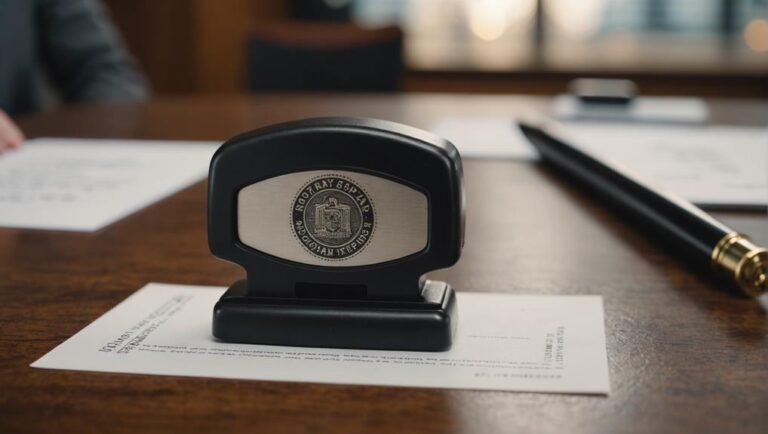Notaries use blue ink to uphold legal traditions and guarantee document authenticity. Blue ink is obligatorily used in many jurisdictions to add an extra layer of security to signatures, especially in real estate transactions. The distinctive color aids in differentiating originals from copies, safeguarding against fraud. By maintaining the highest standards of authenticity, notaries protect the integrity of handled documents. The professional use of blue ink not only projects an image of trustworthiness but also simplifies verification processes. Embracing this tradition reflects a commitment to professionalism and client assurance.
Key Takeaways
- Blue ink is a legal tradition ensuring document authenticity.
- It prevents tampering and enhances document security.
- Blue ink signifies professionalism and industry standards.
- It aids in universal recognition and client confidence.
- The practice safeguards legal integrity and prevents fraud.
Legal Recognition and Tradition
Blue ink is a legal tradition among notaries, serving to distinguish their seal and signature. Notaries use blue ink as mandated by many jurisdictions, ensuring the legal authenticity of documents.
This practice is important in the field of real estate transactions, where the use of blue ink enhances document security. The requirement for notaries to use blue ink is deeply rooted in the law, with the ink color aiding in making original signatures easily distinguishable from copies or scans.
By adhering to this tradition, notaries uphold the significance of their seal and signature on legal documents. The use of blue ink by notaries is universally recognized, simplifying the verification process and promoting acceptance by all parties involved.
This longstanding practice not only adds a layer of formality and professionalism but also signifies the commitment of notaries to uphold the integrity of the documents they notarize.
Document Authenticity
Ensuring document authenticity is a foundational aspect of notarization procedures. The use of blue ink plays a pivotal role in this process by making original signatures easily distinguishable from copies or scans.
Particularly in real estate transactions, where the stakes are high, the distinct color of blue ink enhances the authenticity of signatures and helps prevent tampering or alterations. By utilizing blue ink, notaries add an extra layer of security to notarized documents, reducing the risk of fraud and disputes related to document authenticity.
This practice is deeply rooted in the goal of safeguarding the integrity of handled documents, emphasizing the importance of maintaining the highest standards of authenticity in legal matters.
Document Tampering Prevention
To enhance document security and minimize the risk of tampering, notaries employ specific measures during the notarization process.
One key method in preventing tampering is the use of blue ink. This choice of ink color is essential for document security as it significantly reduces the likelihood of alterations in notarized documents. By opting for blue ink, notaries make any attempts at tampering more noticeable, thereby safeguarding the integrity of the handled documents.
The distinct color of blue ink plays a crucial role in fraud prevention and risk reduction, as it adds an extra layer of assurance to signatures. This measure helps to authenticate notarized documents and prevent unauthorized alterations, ensuring their legal validity and authenticity.
Professionalism and Industry Standards
Maintaining a professional demeanor and adhering to industry standards are paramount in the field of notarization. Using blue ink in notarizations is a key aspect of professionalism and compliance with industry norms. Here's why it matters:
- Professional Image: Blue ink usage helps notaries project a professional image, showcasing their commitment to upholding industry standards.
- Client Confidence: Clients often associate blue ink with notarizations, which instills confidence in the validity and authenticity of the documents notarized.
- Industry Recognition: Within the mortgage industry, the use of blue ink is considered essential for maintaining professionalism and meeting industry standards.
- Simplified Verification: Blue ink's universal recognition in notarizations simplifies the verification and recognition processes, aiding in the efficiency and accuracy of document authentication.
Universal Recognition
Blue ink's widespread recognition within the notary industry underscores its importance in ensuring document authenticity and security. Universally acknowledged for its authenticity and security features, blue ink plays a crucial role in maintaining consistency in notary signatures and simplifying recognition processes.
Serving as an industry standard for notarizations, the use of blue ink streamlines acceptance by all parties involved. Clients place their confidence in services marked by blue ink, associating it directly with notarizations. Additionally, blue ink enhances the professional image of notaries, particularly within the mortgage industry, where it's a key element.
Its universal recognition not only adds a layer of security but also instills a sense of trust and reliability in the documents notarized. Embracing blue ink not only upholds industry standards but also solidifies the bond of trust between notaries and their clients.
Ink Color Requirements for Notaries
The requirement for specific ink colors in notarizations, such as blue ink, is a standard practice enforced by many jurisdictions to uphold document authenticity and legal traditions.
When notarizing documents, the use of blue ink is necessary to distinguish original signatures clearly. The State of New York, for example, mandates that all documents be signed in blue ink to enhance their authenticity. Notaries are expected to use blue ink to fulfill their duty as public officers responsibly.
Using blue ink in notarized documents adds an extra layer of confidence and helps instill trust in the validity of the signatures. Adherence to these industry standards guarantees that notarized documents are universally recognized, simplifying verification processes and facilitating acceptance by all parties involved.
Notary Signature and Seal Details
Notarization standards dictate that the notary's signature and seal must be applied manually in ink on the notarial certificate, in accordance with state regulations. This requirement safeguards the official nature of the notarial act and underscores the significance of handwritten signatures for compliance with legal standards.
Notaries are obligated to affix their signature and seal after completing the notarial act, prohibiting the use of facsimile stamps or electronic printing methods to preserve the document's legality.
The seal used by notaries must meet specific conditions outlined by state regulations to uphold its official status and validity. While some notaries with disabilities may use a signature stamp, approval from the Secretary is necessary to ensure a clear depiction and legibility.
Careful consideration and adherence to state guidelines are essential when using a signature stamp to maintain the integrity and legality of notarized documents. It's vital for notaries to follow these procedures diligently to meet the required standards and uphold the authenticity of their work.
Frequently Asked Questions
What Color Ink Is Best for Notary?
For notary signings, blue ink is ideal. Red ink, while legally acceptable in some places, may not meet professional standards. Blue ink enhances document security, prevents fraud, and guarantees authentication of official documents, emphasizing the importance of ink color in notary stamping.
Why Is Blue Ink Preferred?
Blue ink's symbolism in notary traditions signifies authenticity and professionalism. Its choice isn't just about ink color psychology; it's about maintaining legal standards, enhancing document authentication, preventing fraud, ensuring signature clarity, and upholding historical practices.
Why Is It Important to Write With Blue Ink?
To write with blue ink is essential for notaries. It guarantees signature verification, document authentication, and compliance with legal requirements. Blue ink prevents fraud, marks official records, and upholds professional standards. It is necessary for identification purposes and follows notary guidelines.
Is It Better to Write in Blue or Black Ink?
When signing documents, opt for blue ink over black. Not only does it meet legal requirements, but it also enhances the professionalism of your signature. Plus, blue ink stands out, making your notarizations more official and secure.
Conclusion
Finally, notaries utilize blue ink for a variety of reasons, including legal acknowledgment, document authenticity, and professionalism.
As the saying goes, 'better safe than sorry,' so using blue ink guarantees that important documents are secure and easily recognizable.
So next time you see a notary's signature in blue ink, remember the significance of this tradition in upholding the integrity of important legal documents.






